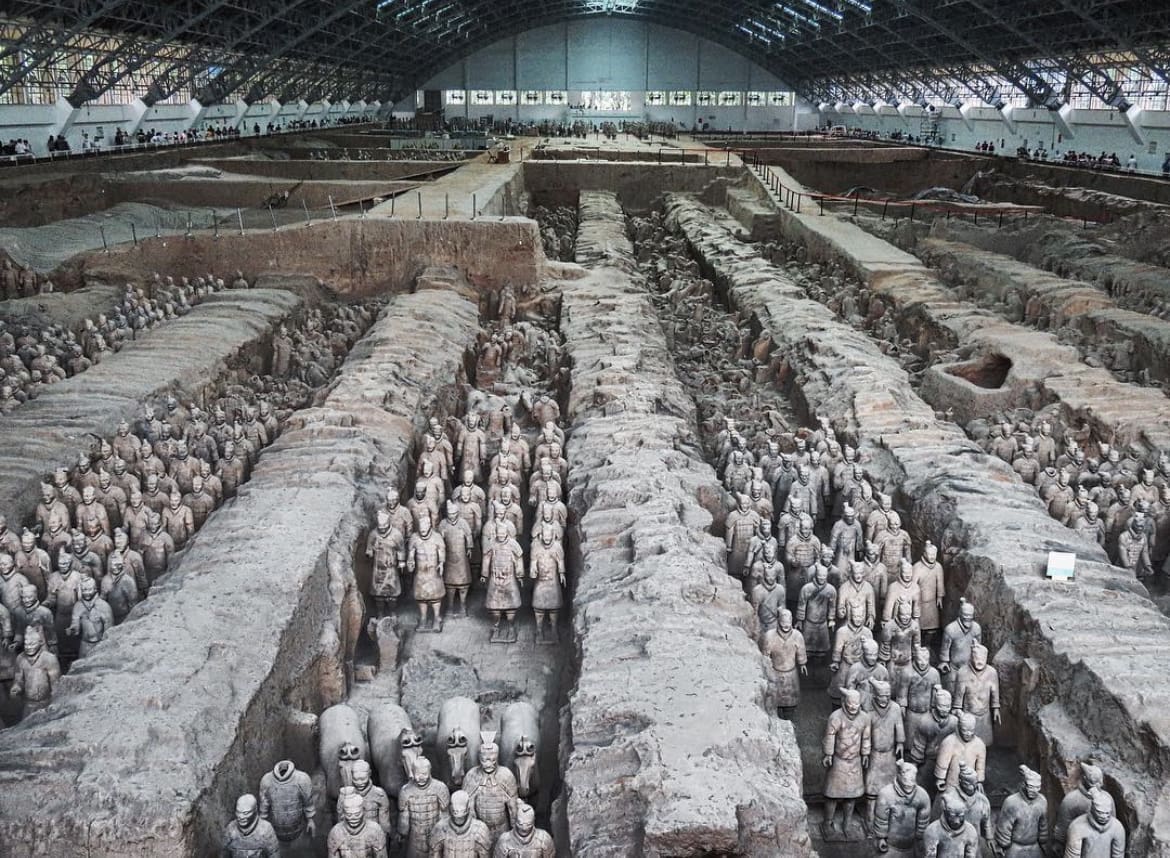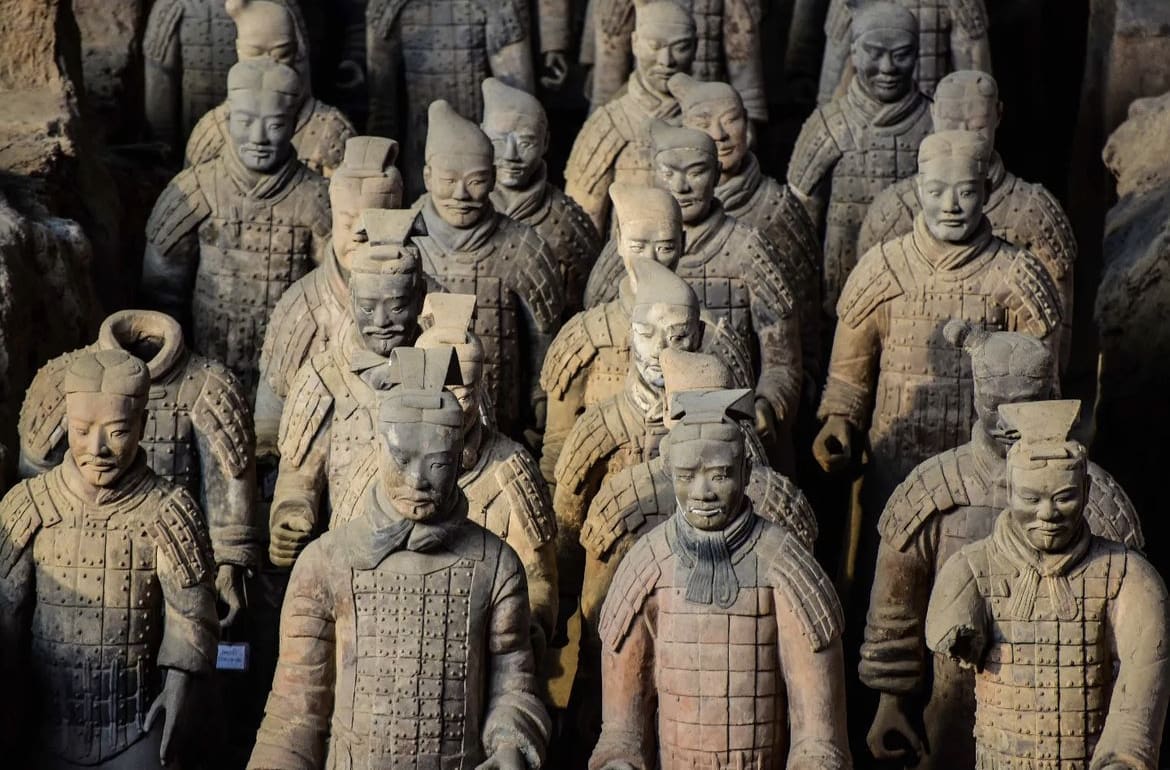Imagine stumbling upon one of the greatest archaeological finds of the 20th century while digging a well in your backyard. That’s exactly what happened to a group of farmers in Xi’an, China, in 1974, when they unearthed the first of what would be thousands of life-sized terra-cotta warriors buried for over two millennia.
These statues, crafted with astounding detail, were meant to guard the tomb of China’s first emperor, Qin Shi Huang, in the afterlife. Today, the terra-cotta warriors are not just silent sentinels of history; they are celebrated icons of ancient craftsmanship and imperial ambition.
In this article, we dive deep into the intriguing world of the terra-cotta warriors, exploring their historical roots, the secrets they hold, and their lasting impact on both culture and tourism. Join us as we uncover everything you need to know about China’s terra-cotta warriors, bridging the past with the present in this timeless saga of clay and spirit.

History Unearthed
The terra-cotta warriors were discovered quite by accident on a spring day in 1974 when local farmers were digging a well on the outskirts of Xi’an, Shaanxi province. This accidental discovery unveiled one of the most significant archaeological finds in the world, shedding light on the practices and beliefs of ancient China. The warriors were commissioned by Emperor Qin Shi Huang, the founder of the Qin dynasty and the first emperor of a unified China. Known for his monumental projects like the Great Wall and his own mausoleum, the emperor believed in an afterlife where he would continue to rule with the same military power and authority as he did in the living world.
The creation of the terra-cotta army was a massive undertaking. Thousands of craftsmen worked for decades, sculpting every soldier with distinct facial features, clothing, and weaponry to reflect their ranks and roles. This level of detail was not only a testament to the emperor’s power but also to the incredible craftsmanship of Qin artisans. These figures, varying in height, armor, and hairstyle based on military rank, were part of a larger necropolis designed to mirror the urban plan of the capital city and serve as the emperor’s last stronghold in the afterlife.
Each warrior was originally painted with bright colors, though most of the paint has faded or peeled off after centuries of exposure. Recent technological advancements have allowed scientists to find traces of the original pigments, providing insights into what the army would have looked like in its full, vibrant glory. This ongoing excavation and research continue to unveil new findings, keeping the terra-cotta warriors at the forefront of archaeological and historical scholarship.

A Closer Look at the Warriors
Delving deeper into the terra-cotta army reveals a complex array of figures, each uniquely crafted to represent a specific military role within Emperor Qin Shi Huang’s grand mausoleum complex. The main types of figures include general officers, infantrymen, cavalrymen, archers, and charioteers, each distinguished by their attire, weaponry, and even facial expressions that reflect the sophistication of the Qin dynasty’s military hierarchy.
The symbolism behind these warriors is profound. They were not merely statues but symbols of the emperor’s ability to command his army beyond the mortal realm, ensuring protection against any malevolent forces in the afterlife. This spiritual and protective role is complemented by the strategic arrangement of the warriors in typical battle formations, suggesting that they were as much a demonstration of military might as a means of afterlife security.
Recent archaeological efforts have unearthed exciting new elements of the terra-cotta army, including wooden chariots and bronze weapons, which have remarkably withstood the test of time due to advanced preservation techniques. Furthermore, initial scans and explorations of other pits within the emperor’s tomb complex suggest that what has been uncovered so far may only be a fraction of the total ensemble, hinting at the presence of additional warriors and artifacts yet to be discovered.

Technological Marvels and Mysteries
The preservation and study of the terra-cotta warriors utilize cutting-edge technology that illuminates both the past craftsmanship and present-day preservation efforts. Techniques such as infrared scanning, 3D imaging, and multi-spectral photography have revealed previously hidden details, such as the intricacy of the warriors’ armor and the faint remnants of paint that once covered them. These technological tools not only help in preserving the fragile relics but also offer a window into the methods and materials used by the ancient artisans.
One of the most intriguing aspects of the terra-cotta army involves the preservation of the warriors’ weapons. Many of the bronze swords, spears, and arrows were found in remarkable condition, some still sharp and shiny, coated with a layer of chromium oxide, a technique not used elsewhere until modern times. This suggests a highly advanced understanding of metallurgy by the Qin dynasty craftsmen, far ahead of their time.
Beyond the artifacts themselves, there is the unopened burial mound of Emperor Qin Shi Huang, which remains a mystery to this day. Historical records suggest that the tomb contains rivers of mercury and a detailed celestial map, designed to mirror the empire over which the emperor once ruled. Concerns about preservation and safety have prevented archaeologists from excavating the main burial chamber. The mystery of what lies within adds a layer of intrigue and speculation about the full extent of the tomb’s contents and the technological innovations that might still be undiscovered.

The Terra-Cotta Warriors Today
Since their discovery, the terra-cotta warriors have transcended their ancient origins to become global ambassadors of Chinese history and culture. Exhibitions of these impressive statues have traveled to museums around the world, drawing crowds and inspiring awe wherever they go. Each exhibition offers a glimpse into the life and times of the Qin dynasty, showcasing the intricate details and individuality of each warrior, alongside artifacts that provide context about their creation and purpose.
The impact of these traveling exhibits on tourism cannot be overstated. Back in Xi’an, the site where the warriors were found has been transformed into one of China’s most visited tourist destinations. The Museum of Qin Terra-cotta Warriors and Horses attracts millions of visitors each year, eager to see the army in its original discovery site. This influx of tourists has spurred significant economic growth in the region, with new hotels, restaurants, and services catering to international visitors.
Culturally, the terra-cotta warriors have made a lasting impact as well. They are often referenced in films, literature, and popular media, symbolizing ancient wisdom and the mysteries of the past. Their iconic status serves as a cultural bridge, connecting people from various parts of the world to Chinese history and heritage.

See Them For Yourself
If you’re planning a visit to see the terra-cotta warriors, a little preparation will go a long way in enhancing your experience. The museum complex in Xi’an is extensive, and the best time to visit is during the off-peak seasons of spring and autumn when the crowds are smaller and the weather is mild. It’s advisable to book your tickets in advance, and consider hiring a knowledgeable local guide to gain deeper insights into the history and mysteries of the site.
For those unable to travel to China, virtual tours offer an accessible alternative. These online resources provide detailed views of the warriors and the excavation sites, along with rich commentary on their historical context. Whether you’re viewing the warriors in person or online, the experience is nothing short of mesmerizing, offering a direct link to China’s ancient past.
Additionally, while in Xi’an, take the opportunity to explore other historical sites. The city is rich with history, home to the ancient City Wall, the Bell and Drum Towers, and the Muslim Quarter, which offers a vibrant taste of local cuisine and culture. Each site tells part of the story of this ancient capital, enriching your understanding of China’s diverse heritage.
The terra-cotta warriors stand as a monumental testament to ancient Chinese artistry and imperial power. Each figure, from the foot soldiers to the generals, from the horses to the chariots, encapsulates a story waiting to be told. As ongoing archaeological work continues to reveal more secrets, our understanding of these figures may change, but their impact remains undiminished.
They are more than just statues; they are a bridge connecting the past to the present, a source of inspiration and wonder, and a reminder of the human capacity for creativity and dedication. As you reflect on the legacy of the terra-cotta warriors, consider the deep history they represent and the countless stories they have yet to reveal.
